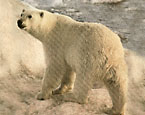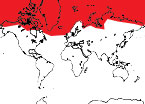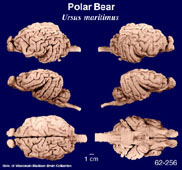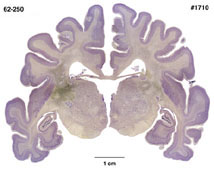|
Polar
Bear
(Ursus maritimus) #62-250 |
||||
|
|
Physical
characteristics and distribution
|
|
Polar Bears are pure white following the spring molt, but their fur may become yellowish in the summer. The head and body length of polar bears range from 2,000-2,500 mm, tail from 76-127 mm. Females weigh 150-330 kg, while females weigh 300-800 kg. For a short distance, the Polar bear can outrun a reindeer on land. In water, they can reach a swimming speed of about 6.5 km/hr. The neck of a polar bear is longer than that of other bears and their heads are relatively smaller and flatter. Polar
Bears feed primarily on ringed seals, which they catch
at or near their breathing holes in the pack ice.
The bear either remains still near a breathing hole,
or stealthily stalks its prey on the ice. In addition,
they eat carcasses of stranded marine mammals, small
land mammals, reindeer, fish, and vegetation. In the
waters they may swim among sea birds and catch them
as they sit on the water. Any individual bear may
make a winter den for temporary shelter during severe
weather, but only females, especially those that are
pregnant, generally hibernate for lengthy periods.
Polar Bears (Ursus maritimus) are considered to be marine mammals, as they are adept swimmers. Their preferred habitat is on pack ice. It may swim as far as 65 km across open water to reach land or ice. There are populations in Canada, Greenland, USA (Alaska), Russia. Circumpolar in the Arctic, S limits determined by ice pack. |
|
Description
of the brain
|
|
Animal
source and preparation
|
|
Our specimen was obtained from the Henry Vilas Park Zoo, in Madison, Wisconsin, and was an old adult male. All specimens collected followed the same preparation and histological procedure. |
Other Related Resources (websites and publications)
List of Specimens | Explore Collections | Brain Sections | Brain Evolution | Brain Development | Brain Circuitry | Brain Functions | Location and Use | Related Web Sites | Contact Us | Search MSU Database | Personnel | Home



